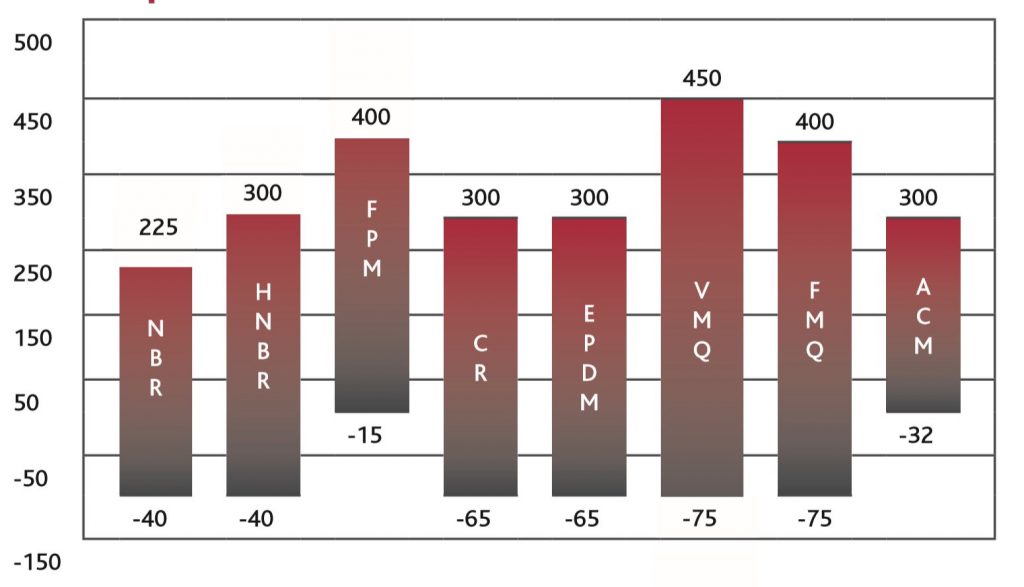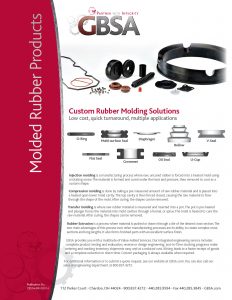Custom Rubber Products: Seals, O-Rings and More
All applications are not created equal. The different sizes, shapes, tolerances and uses will not only determine the design of the molded rubber parts, but also which materials will be best suited for the job.
That’s why our engineers carefully analyze the properties and dynamics of the intended use of the part to ensure our molded rubber parts optimize your operations. Our expertise in a wide variety of elastomers and thermoplastic materials ensures that we deliver greater flexibility and fast turnaround times for a variety of applications including automotive, industrial, electronic, medical, mechanical and household items.
Molded Rubber Parts Seal Types
GBSA molded rubber parts are available in every conceivable configuration to fit your exact application. We have the ability to mold in odd shapes and exotic materials or colors.

We can supply either short or long runs and tooling costs are surprisingly low. Our deliveries are among the fastest in the industry for custom parts, going from concept to delivery in as little as 4 weeks. Our selection of materials is vast to allow our parts to give you the optimum performance in your particular application.
Rubber to Metal Bonding
In addition to manufacturing custom molded rubber parts according to your requirements, we can also assist you with rubber to metal bonding. There are many uses for rubber to metal bonded parts – most commonly associated with isolating vibration or noise during manufacturing processes or in end user equipment. Some examples of parts that bond rubber and metal are oil seals, vibration dampeners, slingers, spacers and washers.
Rubber to metal bonding is a process that adheres rubber to metal parts in order to create a product that has an air-tight and water tight seal. The bonded metal gives the part strength and stiffness so it can withstand high pressure. The bonded rubber provides the metal with elasticity and damping properties. There are a wide variety of applications this process can be used for.
Customer Rubber Molded Solutions
Injection Molding
Injection molding is a manufacturing process where raw, uncured rubber is forced into a heated mold using a rotating screw. The material is formed and cured under the heat and pressure, then removed to cool as a custom shape.
Compression Molding
Compression molding is done by taking a pre-measured amount of raw rubber material and is placed into a heated open lower mold cavity. The top cavity is then forced closed, causing the raw material to flow through the shape of the mold. After curing, the shapes can be removed.
Transfer Molding
Transfer molding is where raw rubber material is measured and inserted into a pot. The pot is pre-heated and plunger forces the material into mold cavities through a funnel, or sprue. The mold is heated to cure the raw material. After curing, shapes can be removed.
Rubber Extrusion
Rubber extrusion is a process where material is pushed or drawn through a die of the desired cross-section. The two main advantages of this process over the manufacturing processes are its ability to create complex cross-sections and long lengths. It also forms finished parts with an excellent surface finish.
Molded Rubber Parts Seal Elastomer Types
A very important component of a seal is the elastomer type. GBSA can specially compound elastomers for specific sealing requirements. Below we provide general properties and fluid compatibility.
| ELASTOMER TYPE |
HARDNESS
SHORE A |
GENERAL PROPERTIES |
| NITRILE (NBR) Acrylonitrile Butadiene |
35 to 95
|
Low, medium and high nitriles are available based on increasing acrylonitrile content which significantly affects low temperature and fluid swell properties. Nitrile compounds can exhibit very good tear and abrasion resistance and excellent compression set. Unless specifically compounded, they do not have a good resistance to ozone, sunlight or weather.
|
| THERBAN (HNBR) Hydrogenated Acrylonitrile Butadiene |
55 to 75
|
This material is a hydrogenated acrylonitrile butadiene and unlike standard nitriles it exhibits resistance to the ozone and other atmospheric conditions. Therban also exhibits a very good resistance to heat and aging in the 300°F range and refrigeration. All other properties are NBR.
|
| FLUOROCARBON (FPM) Fluorinated Hydrocarbon |
55 to 93
|
This polymer exhibits very good resistance to petroleum products, low compression set and high temperature resistance.
|
| NEOPRENE (CR) Chloroprene |
40 to 70
|
Compounds from neoprene exhibit good ozone and weather resistance. Due to the excellent resistance to refrigerants such as Freon, these compounds are used in refrigeration systems.
|
| ETHYLENE PROPYLENE (EPDM) (EPM) |
35 TO 85
30 TO 80 |
Compounds of this material exhibit excellent resistance to automotive brake fluids and steam as well as ozone, sunlight and weather.
|
| SILICONE (VMQ) | Silicone compounds are noted for their excellent heat resistance and exhibit the best over all temperature range of all available elastomers. Not recommended for dynamic applications.
|
|
| FLUOROSILICONE (FMQ) |
35 TO 80
|
This polymer is used in aerospace and automotive applications for fuel systems. It substitutes FPM where low temperature resistance is required.
|
| POLYACRYLATE (ACM) |
60 TO 80
|
Due to the excellent resistance to automotive transmission fluid, oil, flex, and oxidation cracking, this material is used in power steering and transmission applications. |
Molded Rubber Parts Seal Materials & Temperature

Speak with a Sales or Design Engineer
To better understand our molded rubber parts capabilities for your unique application, please complete our contact form or send an email to [email protected] with a drawing of your part.
If you need assistance in the design of this part or would like to speak with a sales engineer regarding a quote, please call us at 800-837-4272.

